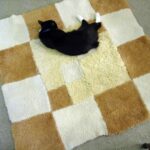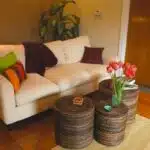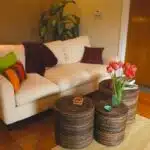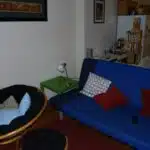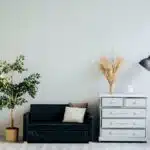When it comes to decorating a room, an area rug can be the perfect finishing touch. Not only does it add color and texture, but it also helps to tie together all of the other elements in the space. However, selecting the right size area rug can be a daunting task. It’s important to not only consider the dimensions of your room but also take into account furniture placement and traffic patterns.
As a home decorating expert, I understand that selecting the perfect size area rug can make or break a room’s design. A poorly sized rug can make a space feel disjointed or cramped while a well-sized rug can create a cozy and inviting atmosphere. In this article, I will share my tips for selecting the right size area rug for your space so that you can feel confident in your decorating choices and create a welcoming environment for yourself and others.
Defining Your Room’s Purpose
Did you know that the purpose of a room affects the size of the area rug you should choose? Before selecting an area rug, it is essential to define your room’s purpose. This is because different rooms have different functions and require varying sizes of area rugs. For instance, a living room rug should be large enough to cover the seating area, while a bedroom rug should only cover the foot of the bed.
When defining your room’s purpose, consider factors such as color schemes and lighting options. The color scheme of your room determines the type of rug you should choose. A neutral-colored room requires a pop of color from a vibrant rug, while a colorful room needs a more subdued rug to balance it out. Similarly, lighting options affect the size of your area rug. A brightly lit room can accommodate smaller rugs since there is already an ample source of light in the space.
In conclusion, defining your room’s purpose is crucial when selecting an area rug. Color schemes and lighting options are key factors to consider in determining which type and size of rug to purchase for each particular space in your home. With these considerations in mind, you can confidently move on to measuring your space for the perfect fit.
Measuring Your Space
Accurately measuring the room size is essential in order to determine the appropriate size of rug needed. It is important to consider the size of the furniture in the room as well as the area of free space when measuring the room size. The size of the rug should be based on the size of the room and the furniture placement. To ensure the rug is the right size, measure the room and subtract the size of the furniture to determine the size of the rug needed.
Measuring Room Size
When it comes to decorating your home, one element that can tie the room together is an area rug. Not only does it provide a cozy feeling underfoot, but it also adds texture and color to the space. However, choosing the right size of rug can be tricky. Measuring your room size is essential in selecting an appropriate area rug.
Before you start measuring your space, consider your room layout and furniture arrangement. If you have a larger room with an open floor plan, a larger area rug would work best as it will help define different areas within the space. On the other hand, for smaller rooms or those with more defined spaces like bedrooms or dining rooms, a smaller area rug may be all that’s needed.
To measure your room size, start by measuring the length and width of your room with a tape measure. Once you have these dimensions, add an extra 2-3 feet to each measurement so that there is enough space for furniture to sit on the rug comfortably. This extra space ensures that when chairs are pulled out from a table or sofa pushed back against a wall, they will still be on the rug and not off onto bare floors.
In conclusion, selecting an area rug that fits perfectly into your space can make or break the overall aesthetic of a room. Measuring your room size accurately is crucial in determining which size of area rugs will work best for your particular layout and furniture arrangement. By following these tips on measuring your space correctly and considering different sizes based on various factors such as open floor plans or smaller rooms, you’ll be able to find just the right fit for any style of home decor!
Determining Rug Size
When it comes to decorating your home with an area rug, one of the most important steps is determining the appropriate size. Calculating dimensions is essential, as a rug that’s too small can make the room feel disjointed and incomplete, while a rug that’s too large can overwhelm the space and create a tripping hazard. Additionally, budget considerations should also be taken into account when selecting an area rug.
To determine the correct size of a rug for your space, start by measuring the length and width of the room with a tape measure. Once you have these dimensions, consider leaving at least 18 inches of exposed flooring around the perimeter of the room to create a border between the rug and walls. This will give your space a more balanced look and feel. When considering budget constraints, keep in mind that smaller rugs are usually less expensive than larger ones.
Another factor to consider when determining rug size is furniture placement. In living rooms, for example, all furniture legs should ideally rest on top of the rug or at least touch its edges. This creates visual cohesion and makes the seating area feel more cohesive. In dining rooms, measure your table and add at least two feet to each side to accommodate chairs comfortably while still keeping them on top of the rug. With these tips in mind, you’ll be able to select an area rug that fits perfectly into your space both aesthetically and functionally.
Considering Furniture Placement
When selecting the right size area rug for a room, it’s important to consider the furniture placement. The arrangement of your furniture can have a significant impact on the overall look and feel of the space, as well as how comfortable and functional it is. Before choosing a rug size, take some time to think about how you want your furniture arranged.
Consider the focal point of the room when deciding on furniture placement. This could be a fireplace, window with a view, or even a piece of artwork. Arrange your seating around this focal point to create a cozy and inviting atmosphere. Be sure to leave enough space between pieces for easy movement – at least 18 inches is recommended.
Another key factor to keep in mind when arranging furniture is room flow. You want to make sure that there’s enough space for people to move around comfortably without feeling cramped or crowded. Think about how you’ll use the room – will you be entertaining guests? Watching TV? Reading? Arrange your furniture accordingly to create a functional and inviting space.
- Use an area rug under your dining table to anchor the space and protect your flooring.
- Place a rug under your coffee table and surrounding seating area for added comfort and style.
- Consider layering rugs for added texture and dimension.
- Choose a rug that complements the colors in your existing décor for a cohesive look.
With careful consideration of furniture arrangement and room flow, you’ll be able to choose an area rug that perfectly fits both your style and practical needs. Next up, we’ll discuss determining traffic patterns within the room.
Determining Traffic Patterns
As a home decorating expert, I understand that choosing the right area rug can be daunting. It’s not just about the design impact or color coordination, but also about determining traffic patterns in your space. This step is crucial as it ensures that you select an appropriate size and shape of the rug.
When considering traffic patterns, think about how people move around your room. Are there areas where there is more foot traffic than others? Do you have furniture pieces that are frequently used? Identifying these traffic patterns will help you determine where to place your rug and what size to choose. For example, if you have a high-traffic area, consider opting for a durable material like wool or synthetic fiber.
Design impact and color coordination are equally important when selecting an area rug, but they should not be prioritized over determining traffic patterns. Once you have identified the areas with high foot traffic, you can start thinking about colors and designs that complement your existing decor. Remember that your rug is a focal point of the room, so choose wisely. By taking all these factors into account, you’ll be on your way to selecting the perfect area rug for your space.
With traffic patterns identified and design and color preferences considered, it’s time to move onto choosing your rug material. Different materials offer different levels of durability, comfort, and maintenance requirements. Let’s take a look at some popular options in the next section.
Choosing Your Rug Material
Having determined the traffic patterns in your home, it is now time to select the right size area rug. The size of your rug will depend on the dimensions of the room and furniture arrangement. A rug that is too small will make the space look disjointed, while a rug that is too large will overwhelm the room. To ensure that you choose the right size area rug, measure your room and furniture placement before making a purchase.
Once you have determined the appropriate size for your area rug, it is time to consider rug material factors. Each type of rug material has its unique characteristics that affect durability and maintenance requirements. For example, synthetic fibers like nylon are durable and easy to clean, while natural fibers like wool offer an elegant look but require more maintenance. When selecting a rug material, consider how much foot traffic there will be in the space and whether or not you have pets or children.
Durability considerations are also essential when choosing an area rug. You want a rug that can withstand daily wear and tear without needing frequent replacement. Factors such as fiber density, pile height, and backing materials all contribute to a rugs durability. Investing in a quality area rug may cost more upfront, but it could save you money in the long run by reducing replacement costs. Ultimately, by considering both durability factors and selecting an appropriate size for your space, you can find an area rug that enhances both form and function in any room of your home.
Understanding Rug Pile Height is another crucial factor when selecting an area rug for your home. Different pile heights can create different textures and add depth to a room’s design theme. Understanding how each pile height contributes to aesthetics can help you achieve desired results with ease. Let’s explore this topic further in detail in our subsequent section: Understanding Rug Pile Height.”
Understanding Rug Pile Height
When shopping for area rugs, it’s essential to consider the pile height. Pile height refers to how tall the rug fibers are above the backing. Understanding the pros and cons of different pile heights can help you select the right texture for your space.
High-pile rugs, such as shag or frieze, have fibers that stand tall and create a plush feel underfoot. These types of rugs are excellent for adding warmth and texture to a room but may not be ideal for high-traffic areas or homes with pets as they are harder to clean. Low-pile rugs, on the other hand, have shorter fibers and are easier to clean, making them a better choice for high-traffic areas.
Medium-pile rugs offer a balance between comfort and practicality. They provide cushioning underfoot while still being easy to vacuum and maintain. When selecting an area rug, consider the function of the room where it will be placed and choose a pile height that complements your space’s needs. In the subsequent section, we’ll discuss selecting the shape of your rug to complete your home decor vision seamlessly.
Understanding rug pile height is crucial when choosing an area rug that fits your needs aesthetically and practically. High-pile rugs offer plushness but require more maintenance than low-pile ones; medium-pile rugs strike a balance between comfort and practicality. Selecting an area rug with appropriate pile height can make all the difference in creating an inviting space that leaves you feeling comfortable while being visually pleasing at the same time. In our next section, we’ll discuss how selecting an appropriate shape can enhance your home decor even further without compromising on functionality or aesthetics.
Selecting The Shape Of Your Rug
When it comes to selecting the shape of your rug, it’s important to consider both the room decor and the purpose of the rug. The most common rug shapes are rectangular, round, and square, each with its own unique characteristics that can either complement or detract from your overall design aesthetic. Rectangular rugs tend to be the most versatile option as they can fit into a variety of spaces and work well under furniture such as sofas or dining tables.
The shape of your rug should also match the function of the room. For example, a round rug may be better suited for a cozy reading nook while a rectangular rug may work better in a larger living room where you want to define different seating areas. Additionally, if you have an open floor plan, using multiple rugs in different shapes can help create visual boundaries between different areas without sacrificing flow.
Overall, choosing the right rug shape can make all the difference in tying together your room decor. Take into consideration both practicality and design aesthetics when making your decision. In the next section, we will explore why rectangular rugs are often the best choice for many spaces and how to properly measure for one.
Rectangular Rugs
Like a puzzle piece, the shape of your rug must fit seamlessly into your room’s design. Once you’ve selected the appropriate shape, it’s time to consider size. While it may be tempting to choose a large area rug to cover as much floor space as possible, this can actually make your room appear smaller. On the other hand, choosing a rug that is too small can make everything else in the room feel disjointed.
When selecting a size for your area rug, it’s essential to measure the space accurately. Consider the furniture arrangement in the room and ensure that at least two legs of each piece of furniture are resting on the rug. If it’s only possible to fit one leg on the rug, choose a smaller size or opt for multiple smaller rugs to create defined seating areas.
Another factor to consider when selecting a size is rug materials and color palettes. If you’re working with bold colors or patterns, choosing a larger size can help balance out the design without overwhelming the space. Additionally, if you’re using natural fibers such as wool or jute, they tend to shed more in larger sizes and may require more frequent maintenance. By taking these factors into account, you can select an appropriately sized area rug that will bring together all elements of your interior design.
Moving onto rectangular rugs brings about new possibilities for arranging and defining spaces within your home.
Square Rugs
When it comes to decorating a room, one of the essential elements is the area rug. It can bring together all the other furniture and décor in the space. Square rugs are an excellent choice for many rooms because of their unique benefits.
One of the main advantages of square rugs is their versatility. They work well in nearly any room, from living rooms to bedrooms and even entryways. They also come in a wide range of sizes, making them perfect for both large and small spaces. Additionally, square rugs can help define different areas within a room, such as creating a seating area or delineating a dining space.
When it comes to placement, there are several options for square rugs depending on the room’s layout. One popular approach is to center the rug under a coffee table or other focal point in the living room. In bedrooms, you can place a square rug at the foot of the bed or underneath it entirely. For entryways or hallways, consider using a runner-style square rug to create visual interest and guide guests into your home.
To evoke emotion in our audience when considering square rugs for their homes, we recommend keeping these three things in mind:
- Square rugs can add character to any space while providing warmth and comfort underfoot.
- The variety of sizes available makes it easy to find one that fits your needs perfectly.
- When placed correctly, they can make your furniture arrangement appear more cohesive and polished.
Now that we’ve explored the benefits and placement options for square rugs let’s move onto round rugs – another versatile option that can enhance any space with its unique shape and style!
Round Rugs
When selecting a round rug, it is important to determine the size of the rug to ensure it fits within the intended space. Measuring the area first will help determine the right size of rug needed. Additionally, when selecting a round rug, consider the color of the rug and how it will complement the existing decor in the room. Be sure to choose a color that will fit and enhance the existing design of the room.
Determining Rug Size
Round rugs can be a great addition to any room, but it’s important to choose the right size to ensure visual impact and functionality. When determining rug size for a round rug, start by calculating the dimensions of your space. Measure the diameter of the table or furniture you’ll be placing on top of the rug and add at least 2 feet on all sides to allow for movement and proportion.
It’s also important to consider the visual impact of your round rug. A rug that is too small can look lost in a larger room, while a rug that is too large can overwhelm a smaller space. To strike the right balance, choose a round rug that is proportional to your furniture and creates a sense of harmony with other design elements in the room.
Ultimately, selecting the right size round rug comes down to finding the perfect balance between form and function. By taking accurate measurements and considering visual impact, you’ll be able to find a round rug that enhances your space both aesthetically and practically. Remember that home decorating is about serving yourself and others in creating an environment that brings joy and comfort into everyday life.
Choosing Rug Color
When it comes to round rugs, choosing the right color is just as important as selecting the appropriate size. Color coordination is essential to achieve a cohesive and aesthetically pleasing look in any room. However, it’s not just about matching colors; contrasting patterns can add interest and dimension to your space.
One of the first things to consider when choosing a rug color is the existing color scheme in your room. The rug should complement or contrast with the wall color, furniture, and accessories. If your space has neutral tones, you can use a bold colored rug as an accent piece. On the other hand, if your room already has bold colors and patterns, a solid-colored rug may be more suitable.
Another tip for choosing the right round rug color is to think about the mood you want to create in your room. For example, blue and green hues are calming and work well in bedrooms or living rooms where relaxation is key. Brighter colors like reds and oranges can create a more energizing atmosphere in spaces like home offices or kitchens. Don’t be afraid to play around with different shades and textures until you find the perfect match for your space!
Oval Rugs
In our previous section, we talked about the benefits of using round rugs in your home decor. Now, let’s shift our focus to oval rugs.
One of the most significant benefits of oval rugs is that they can fit perfectly into any room. They are versatile and adaptable to a wide range of interior design styles. Oval rugs are also perfect for creating a sense of flow and unity within a space. With their elongated shape, they can help guide you from one area to another while also connecting different pieces of furniture together.
When it comes to placing oval rugs in your home, there are some essential tips to keep in mind. First, consider the size of your room before selecting an oval rug. You want to make sure that the rug is proportional to the size of your space so that it does not look too small or too large. Additionally, think about the furniture layout and how the rug will interact with it. For example, if you have a circular coffee table, an oval rug could complement its shape nicely.
Moving forward into our next section, let’s explore runner rugs and how they can add both functionality and style to your home decor scheme.
Runner Rugs
When selecting a runner rug for your home, it is important to consider the size measurement of the space you are looking to fill. The material of the rug should also be taken into account, as certain materials may require more maintenance than others. Placement of a runner rug should also be considered, as the rug should be able to be placed in the desired location without becoming a tripping hazard. Additionally, when choosing a runner rug, it is important to take into consideration the furniture in the room, as the size of the rug should complement the furniture in the area. Furthermore, when selecting a runner rug, it may be beneficial to opt for a rug with a non-skid backing to reduce the risk of slipping. Finally, it is important to take into consideration the existing decor and color scheme of the space to ensure that the rug you select complements the area.
Measurement
Determining the right size area rug is a crucial factor in achieving a cohesive and polished room layout. The perfect rug can anchor your furniture and define the space, while also adding warmth and texture to your design aesthetic. Before making any purchases, it is essential to measure the area where you intend to place your runner rug.
To ensure a well-proportioned rug, you should consider the room’s layout and furniture arrangement. A runner rug that is too small can make a space feel disjointed or unbalanced. On the other hand, an oversized rug can overwhelm the room’s design aesthetic, making it feel cramped and cluttered. Additionally, you should take into account any doorways or entryways that may require clearance.
Measuring your space accurately will save you time and money in finding the perfect runner rug for your home decor needs. When measuring, be sure to account for any furniture legs that will be resting on top of the rug. A general rule of thumb for runners is to leave at least six inches of floor space between the edge of the rug and surrounding walls or furniture. By following these guidelines, you can confidently select a runner rug that enhances your room’s layout and elevates its design aesthetic without sacrificing function or style.
Material
When it comes to selecting the perfect runner rug for your home, there are several factors to consider. One of the most important is the material of the rug. Runner rugs can be made from a variety of materials, including natural fibers like wool and cotton or synthetic options like nylon and polyester. Each material has its own set of benefits and drawbacks, so it’s essential to weigh these factors before making a purchase.
Natural fiber runner rugs are often more expensive than their synthetic counterparts but offer several advantages. Wool, for example, is durable, naturally stain-resistant, and has excellent insulating properties. Cotton is another popular natural option that is easy to clean and maintain. Synthetic runner rugs are typically less expensive than natural fiber options but may lack some of their benefits. However, they are often more durable and easier to clean.
Another crucial factor to consider when selecting a runner rug is texture. Plush rugs with a high pile height can add warmth and comfort to a room while flat weave rugs offer a sleeker look that works well in modern spaces. The right texture will depend on your personal style preferences as well as the overall design aesthetic of your home.
Ultimately, finding the perfect runner rug requires careful consideration of both material and texture. By weighing the pros and cons of each option and taking into account your personal style preferences, you can select a rug that not only looks beautiful but also serves your practical needs for years to come.
Placement
A well-placed runner rug can add a touch of elegance and functionality to any room. However, it’s essential to consider the placement of the rug carefully. Room layout is a crucial factor to consider when selecting the perfect spot for your runner rug. A narrow hallway, for example, may require a different orientation than a wide open living room.
When considering placement options, it’s important to think about how you want the rug to interact with other elements in the room. If you have furniture that runs parallel to the wall, orienting your runner rug in the same direction can help create a cohesive look. Alternatively, placing your runner rug perpendicular to your furniture can help define separate spaces within an open floor plan.
Finally, don’t be afraid to get creative with your placement options. Placing a runner rug under a bed or along the side of a kitchen island can add visual interest and functionality to these areas. With careful consideration of room layout and rug orientation, you can find the perfect spot for your runner rug that both enhances your home decor and serves your practical needs.
Layering Rugs For Added Depth
Mixing textures and layering rugs is a great way to add depth, pattern, and color to your space. This technique involves layering one rug on top of another, creating a cozy look that adds visual interest to any room. When layering rugs, it’s important to choose complementary colors and textures that work well together.
One way to coordinate colors when layering rugs is to choose two rugs with similar color palettes. For example, if you have a blue area rug as your base layer, consider adding a complementary patterned rug in shades of blue and white on top. You can also mix different textures by combining a plush wool rug with a flat-woven jute or sisal rug. The key is to experiment with different combinations until you find the perfect match.
When layering rugs, keep in mind that less is often more. Too many layers can make your space feel cluttered and overwhelming. Stick to two or three layers at most, and make sure each rug has enough space around it so it doesn’t appear cramped or crowded. With the right combination of colors and textures, layered rugs can be an excellent way to add warmth and depth to any room.
Transition: Now that you’ve learned about the benefits of mixing textures and colors when layering rugs, let’s talk about how you can maintain your area rug for years of use.
Maintaining Your Area Rug
Layering rugs can add an extra dimension to your home décor, but if the size of the area rug is not right, it can ruin the entire look. Selecting the right size area rug is crucial for enhancing the room’s aesthetic appeal. According to a recent survey, 8 out of 10 interior designers agree that selecting the right size area rug makes a significant difference in creating a cohesive and inviting space.
When selecting an area rug, keep in mind that it should be large enough to fit all your furniture. The wrong-sized rug can make your furniture appear awkwardly placed or too small for the room. A general rule of thumb is to have at least six inches of space between the edges of your rug and walls or other furniture pieces. If you have a large room, breaking up the space with multiple rugs can create distinct zones.
Once you have selected the right size area rug, it’s essential to take proper care of it through regular maintenance and cleaning. Investing in professional rug cleaning services can help remove tough stains and odors that regular vacuuming cannot eliminate. For everyday spills and stains, use mild soap and water or specialized carpet cleaners designed for specific types of stains such as wine or pet accidents.
In summary, selecting the right size area rug is crucial for creating a cohesive home décor style. It’s important to consider various factors such as furniture placement and room size when making your selection. Additionally, taking care of your area rug by investing in professional cleaning services or using specialized carpet cleaners can help maintain its appearance and longevity over time. With these tips in mind, you’ll be able to finalize your rug selection with confidence knowing that you’ve made a smart investment for your home’s aesthetic appeal and comfort.
Finalizing Your Rug Selection
Once you have narrowed down your options and have a few area rugs in mind, it is time to finalize your selection. One important consideration when making your final decision is color options. You want to make sure the rug complements the colors in your room rather than clashes with them. If you have neutral walls and furniture, you may opt for a bold, colorful rug as a statement piece. On the other hand, if you already have plenty of colors and patterns in your space, a simple, solid-colored rug may be the best choice.
Another factor to consider when finalizing your rug selection is price range. Area rugs can vary greatly in price depending on factors such as material, size, and design complexity. Determine how much you are willing to spend before shopping around so that you don’t get carried away by extravagant options outside of your budget. Remember that investing in a quality rug can pay off in the long run by providing durability and longevity.
When making your final decision on an area rug, be sure to take into account both color options and price range. A well-chosen rug can provide not only aesthetic appeal but also functionality by anchoring furniture and creating a cozy atmosphere. With careful consideration of these factors, you can select the perfect area rug for your home without breaking the bank or sacrificing style.
Conclusion
Selecting the right size area rug for your space is crucial in creating a cohesive and polished interior design. Whether you are decorating a living room, bedroom, or dining area, there are several factors to consider before making your final selection.
Firstly, defining your room’s purpose will help guide your rug selection. For example, if you are designing a cozy reading nook, a smaller rug may be appropriate. However, if you are decorating an open-concept living space, a larger area rug can help define and anchor the seating area.
Measuring your space accurately is also essential. Take note of the room’s dimensions and consider any furniture placement when selecting a rug size. A general rule of thumb is to leave at least 18 inches of bare floor around the perimeter of the room.
Determining traffic patterns will also impact your rug choice. If your space experiences heavy foot traffic, opt for a durable material such as wool or synthetic fibers that can withstand wear and tear.
When selecting your rug material, consider both style and functionality. Natural fibers such as jute or sisal can add texture and warmth to a space but may not be suitable for high-traffic areas. Alternatively, synthetic materials such as nylon or polyester can mimic natural fibers but offer greater durability and stain resistance.
Layering rugs is another trend that adds depth and dimension to any room. Consider layering a smaller patterned rug over a larger solid-colored one for added interest.
Finally, maintaining your area rug is crucial in ensuring its longevity. Regular vacuuming and spot cleaning will keep it looking fresh and vibrant for years to come.
In conclusion, selecting the right size area rug requires careful consideration of several factors including purpose, measurements, furniture placement, traffic patterns, material selection, layering options, and maintenance requirements. By taking these elements into account when making your final decision, you can create an interior design that is both functional and aesthetically pleasing. As the famous interior designer, Nate Berkus once said, “Your home should tell the story of who you are and be a collection of what you love.” Let your area rug selection be a reflection of your style and personality.
Image Credits
- “porn rug” by odavy (featured)



